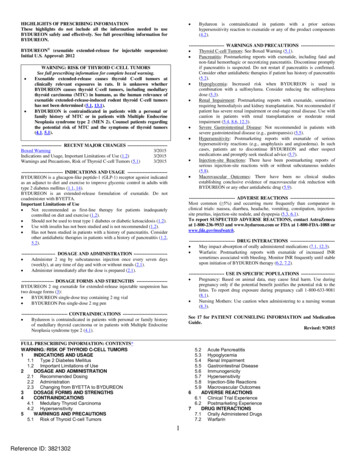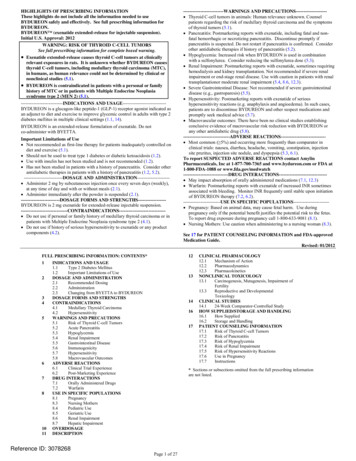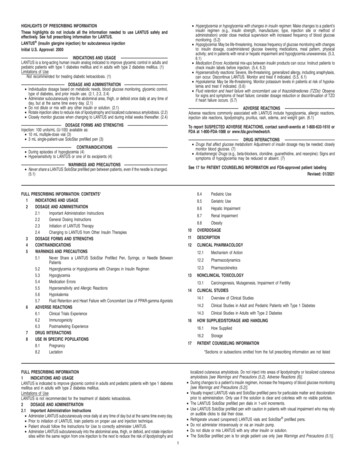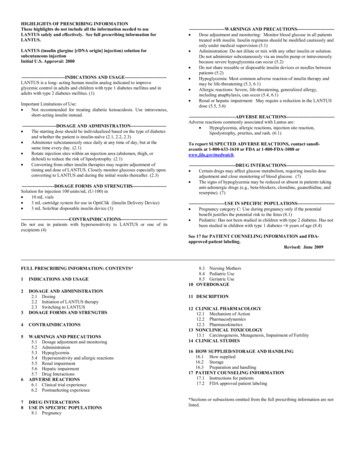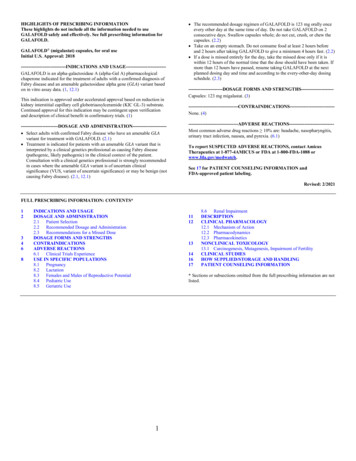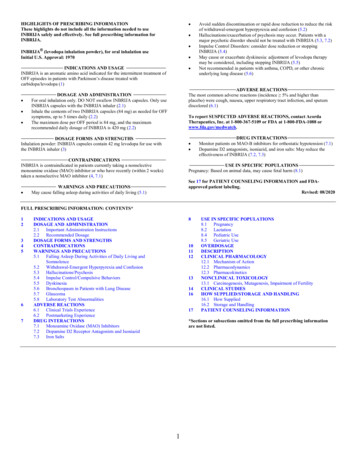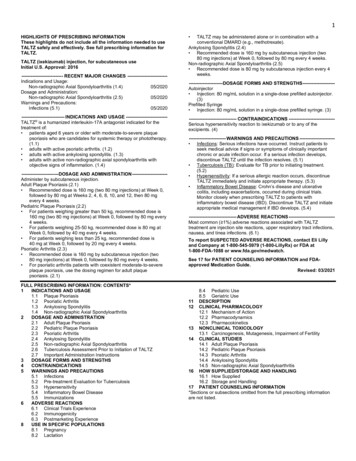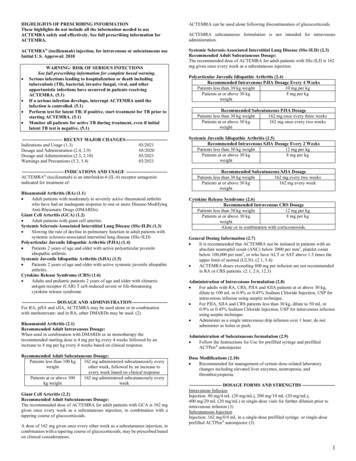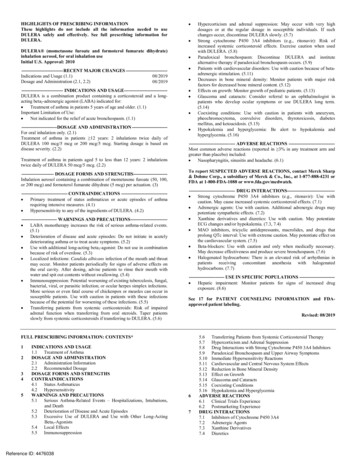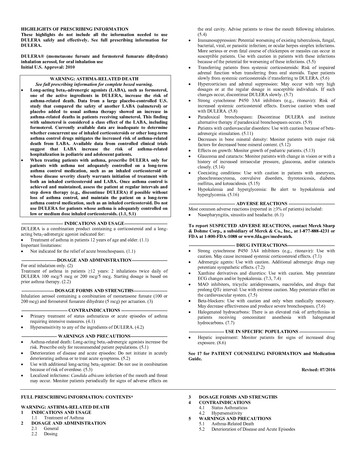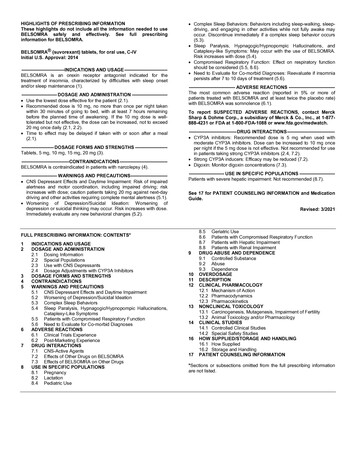
Transcription
HIGHLIGHTS OF PRESCRIBING INFORMATIONThese highlights do not include all the information needed to useSPIRIVA HANDIHALER safely and effectively. See full prescribinginformation for SPIRIVA HANDIHALER. SPIRIVA HANDIHALER (tiotropium bromide inhalation powder),for oral inhalation useInitial U.S. Approval: 2004----------------------------INDICATIONS AND USAGE--------------------------SPIRIVA HANDIHALER is an anticholinergic indicated for the long-term,once-daily, maintenance treatment of bronchospasm associated with chronicobstructive pulmonary disease (COPD), and for reducing COPDexacerbations (1)----------------------DOSAGE AND ADMINISTRATION---------------------- For oral inhalation only. DO NOT swallow SPIRIVA capsules. Onlyuse SPIRIVA capsules with the HANDIHALER device (2) Two inhalations of the powder contents of a single SPIRIVA capsule(18 mcg) once daily (2)---------------------DOSAGE FORMS AND STRENGTHS---------------------Inhalation powder: SPIRIVA capsules contain 18 mcg tiotropium powder foruse with HANDIHALER device S-----------------------------Hypersensitivity to tiotropium, ipratropium, or any components of SPIRIVAcapsules (4) bronchospasm, or anaphylaxis, occur. Use with caution in patients withsevere hypersensitivity to milk proteins. (5.2)Paradoxical bronchospasm: Discontinue SPIRIVA HANDIHALER andconsider other treatments if paradoxical bronchospasm occurs (5.3)Worsening of narrow-angle glaucoma may occur. Use with caution inpatients with narrow-angle glaucoma and instruct patients to consult aphysician immediately if this occurs. (5.4)Worsening of urinary retention may occur. Use with caution in patientswith prostatic hyperplasia or bladder-neck obstruction and instructpatients to consult a physician immediately if this occurs. (5.5)------------------------------ADVERSE REACTIONS------------------------------The most common adverse reactions ( 5% incidence in the 1-year placebocontrolled trials) were upper respiratory tract infection, dry mouth, sinusitis,pharyngitis, non-specific chest pain, urinary tract infection, dyspepsia, andrhinitis (6.1)To report SUSPECTED ADVERSE REACTIONS, contact BoehringerIngelheim Pharmaceuticals, Inc. at (800) 542-6257 or (800) 459-9906TTY, or FDA at 1-800-FDA-1088 or -DRUG inergics: May interact additively with concomitantly usedanticholinergic medications. Avoid administration of SPIRIVAHANDIHALER with other anticholinergic-containing drugs. (7.2)-----------------------USE IN SPECIFIC POPULATIONS-----------------------Patients with moderate to severe renal impairment should be monitoredclosely for potential anticholinergic side effects (2, 8.6)-----------------------WARNINGS AND PRECAUTIONS----------------------- Not for acute use: Not a rescue medication (5.1)See 17 for PATIENT COUNSELING INFORMATION and FDAapproved patient labeling. Immediate hypersensitivity reactions: Discontinue SPIRIVARevised: 2/2018HANDIHALER at once and consider alternatives if immediatehypersensitivity reactions, including angioedema, urticaria, rash,FULL PRESCRIBING INFORMATION: CONTENTS*123458.2 Lactation8.4 Pediatric Use8.5 Geriatric Use8.6 Renal Impairment8.7 Hepatic ImpairmentOVERDOSAGEDESCRIPTIONCLINICAL PHARMACOLOGY12.1 Mechanism of Action12.2 Pharmacodynamics12.3 PharmacokineticsNONCLINICAL TOXICOLOGY13.1 Carcinogenesis, Mutagenesis, Impairment of FertilityCLINICAL STUDIESHOW SUPPLIED/STORAGE AND HANDLINGPATIENT COUNSELING INFORMATIONINDICATIONS AND USAGEDOSAGE AND ADMINISTRATIONDOSAGE FORMS AND STRENGTHSCONTRAINDICATIONS10WARNINGS AND PRECAUTIONS115.1 Not for Acute Use125.2 Immediate Hypersensitivity Reactions5.3 Paradoxical Bronchospasm5.4 Worsening of Narrow-Angle Glaucoma5.5 Worsening of Urinary Retention135.6 Renal Impairment6 ADVERSE REACTIONS146.1 Clinical Trials Experience166.2 Postmarketing Experience177 DRUG INTERACTIONS*Sections or subsections omitted from the full prescribing information are not7.1 Sympathomimetics, Methylxanthines, Steroidslisted.7.2 Anticholinergics8 USE IN SPECIFIC POPULATIONS8.1 Pregnancy
FULL PRESCRIBING INFORMATION1INDICATIONS AND USAGESPIRIVA HANDIHALER (tiotropium bromide inhalation powder) is indicated for the long-term, once-daily, maintenance treatment of bronchospasm associated withchronic obstructive pulmonary disease (COPD), including chronic bronchitis and emphysema. SPIRIVA HANDIHALER is indicated to reduce exacerbations in COPDpatients.2DOSAGE AND ADMINISTRATIONFor oral inhalation only. Do not swallow SPIRIVA capsules, as the intended effects on the lungs will not be obtained. The contents of the SPIRIVA capsulesshould only be used with the HANDIHALER device [see Overdosage (10)].The recommended dose of SPIRIVA HANDIHALER is two inhalations of the powder contents of one SPIRIVA capsule, once-daily, with the HANDIHALER device[see Patient Counseling Information (17)]. Do not take more than one dose in 24 hours.For administration of SPIRIVA HANDIHALER, a SPIRIVA capsule is placed into the center chamber of the HANDIHALER device. The SPIRIVA capsule is piercedby pressing and releasing the green piercing button on the side of the HANDIHALER device. The tiotropium formulation is dispersed into the air stream when thepatient inhales through the mouthpiece [see Patient Counseling Information (17)].No dosage adjustment is required for geriatric, hepatically-impaired, or renally-impaired patients. However, patients with moderate to severe renal impairment givenSPIRIVA HANDIHALER should be monitored closely for anticholinergic effects [see Warnings and Precautions (5.6), Use in Specific Populations (8.5, 8.6, 8.7), andClinical Pharmacology (12.3)].3DOSAGE FORMS AND STRENGTHSInhalation Powder: SPIRIVA HANDIHALER consists of SPIRIVA capsules containing tiotropium powder for oral inhalation and a HANDIHALER device. SPIRIVAcapsules contain 18 mcg of tiotropium in a light green, hard gelatin capsule with TI 01 printed on one side and Boehringer Ingelheim company logo on the other side.The HANDIHALER device is only intended for use with the SPIRIVA capsules.4CONTRAINDICATIONSSPIRIVA HANDIHALER is contraindicated in patients with a hypersensitivity to tiotropium, ipratropium, or any components of this product [see Warnings andPrecautions (5.2)]. In clinical trials and postmarketing experience with SPIRIVA HANDIHALER, immediate hypersensitivity reactions, including angioedema(including swelling of the lips, tongue, or throat), itching, or rash have been reported [see Warnings and Precautions (5.2)].55.1WARNINGS AND PRECAUTIONSNot for Acute UseSPIRIVA HANDIHALER is intended as a once-daily maintenance treatment for COPD and should not be used for relief of acute symptoms, i.e., as rescue therapy forthe treatment of acute episodes of bronchospasm.5.2Immediate Hypersensitivity ReactionsImmediate hypersensitivity reactions, including urticaria, angioedema (including swelling of the lips, tongue, or throat), rash, bronchospasm, anaphylaxis, or itching,may occur after administration of SPIRIVA HANDIHALER. If such a reaction occurs, therapy with SPIRIVA HANDIHALER should be stopped at once andalternative treatments should be considered. Given the similar structural formula of atropine to tiotropium, patients with a history of hypersensitivity reactions toatropine or its derivatives should be closely monitored for similar hypersensitivity reactions to SPIRIVA HANDIHALER. In addition, SPIRIVA HANDIHALERshould be used with caution in patients with severe hypersensitivity to milk proteins.5.3Paradoxical BronchospasmInhaled medicines, including SPIRIVA HANDIHALER, may cause paradoxical bronchospasm. If this occurs, it should be treated immediately with an inhaled shortacting beta2-agonist such as albuterol. Treatment with SPIRIVA HANDIHALER should be stopped and other treatments considered.5.4Worsening of Narrow-Angle GlaucomaSPIRIVA HANDIHALER should be used with caution in patients with narrow-angle glaucoma. Prescribers and patients should be alert for signs and symptoms ofacute narrow-angle glaucoma (e.g., eye pain or discomfort, blurred vision, visual halos or colored images in association with red eyes from conjunctival congestion andcorneal edema). Instruct patients to consult a physician immediately should any of these signs or symptoms develop.5.5 Worsening of Urinary RetentionSPIRIVA HANDIHALER should be used with caution in patients with urinary retention. Prescribers and patients should be alert for signs and symptoms of urinaryretention (e.g., difficulty passing urine, painful urination), especially in patients with prostatic hyperplasia or bladder-neck obstruction. Instruct patients to consult aphysician immediately should any of these signs or symptoms develop.5.6 Renal ImpairmentAs a predominantly renally excreted drug, patients with moderate to severe renal impairment (creatinine clearance of 60 mL/min) treated with SPIRIVAHANDIHALER should be monitored closely for anticholinergic side effects [see Clinical Pharmacology (12.3)].6ADVERSE REACTIONSThe following adverse reactions are described, or described in greater detail, in other sections: Immediate hypersensitivity reactions [see Warnings and Precautions (5.2)]
6.1Paradoxical bronchospasm [see Warnings and Precautions (5.3)]Worsening of narrow-angle glaucoma [see Warnings and Precautions (5.4)]Worsening of urinary retention [see Warnings and Precautions (5.5)]Clinical Trials ExperienceBecause clinical trials are conducted under widely varying conditions, the incidence of adverse reactions observed in the clinical trials of a drug cannot be directlycompared to the incidences in the clinical trials of another drug and may not reflect the incidences observed in practice.6-Month to 1-Year TrialsThe data described below reflect exposure to SPIRIVA HANDIHALER in 2663 patients. SPIRIVA HANDIHALER was studied in two 1-year placebo-controlledtrials, two 1-year active-controlled trials, and two 6-month placebo-controlled trials in patients with COPD. In these trials, 1308 patients were treated with SPIRIVAHANDIHALER at the recommended dose of 18 mcg once a day. The population had an age ranging from 39 to 87 years with 65% to 85% males, 95% Caucasian, andhad COPD with a mean pre-bronchodilator forced expiratory volume in one second (FEV1) percent predicted of 39% to 43%. Patients with narrow-angle glaucoma, orsymptomatic prostatic hypertrophy or bladder outlet obstruction were excluded from these trials. An additional 6-month trial conducted in a Veteran's Affairs setting isnot included in this safety database because only serious adverse events were collected.The most commonly reported adverse drug reaction was dry mouth. Dry mouth was usually mild and often resolved during continued treatment. Other reactionsreported in individual patients and consistent with possible anticholinergic effects included constipation, tachycardia, blurred vision, glaucoma (new onset orworsening), dysuria, and urinary retention.Four multicenter, 1-year, placebo-controlled and active-controlled trials evaluated SPIRIVA HANDIHALER in patients with COPD. Table 1 shows all adversereactions that occurred with a frequency of 3% in the SPIRIVA HANDIHALER group in the 1-year placebo-controlled trials where the rates in the SPIRIVAHANDIHALER group exceeded placebo by 1%. The frequency of corresponding reactions in the ipratropium-controlled trials is included for comparison.Table 1Adverse Reactions (% Patients) in One-Year COPD Clinical TrialsBody System (Event)Body as a WholeChest Pain (non-specific)Edema, DependentGastrointestinal System DisordersDry MouthDyspepsiaAbdominal PainConstipationVomitingMusculoskeletal SystemMyalgiaResistance Mechanism DisordersInfectionMoniliasisRespiratory System (Upper)Upper Respiratory Tract InfectionSinusitisPharyngitisRhinitisEpistaxisSkin and Appendage DisordersRashUrinary SystemUrinary Tract InfectionPlacebo-Controlled TrialsSPIRIVAPlacebo(n 550)(n 371)Ipratropium-Controlled TrialsSPIRIVAIpratropium(n 356)(n 96437975243373135232142227542Arthritis, coughing, and influenza-like symptoms occurred at a rate of 3% in the SPIRIVA HANDIHALER treatment group, but were 1% in excess of the placebogroup.Other reactions that occurred in the SPIRIVA HANDIHALER group at a frequency of 1% to 3% in the placebo-controlled trials where the rates exceeded that in theplacebo group include: Body as a Whole: allergic reaction, leg pain; Central and Peripheral Nervous System: dysphonia, paresthesia; Gastrointestinal SystemDisorders: gastrointestinal disorder not otherwise specified (NOS), gastroesophageal reflux, stomatitis (including ulcerative stomatitis); Metabolic and NutritionalDisorders: hypercholesterolemia, hyperglycemia; Musculoskeletal System Disorders: skeletal pain; Cardiac Events: angina pectoris (including aggravated anginapectoris); Psychiatric Disorder: depression; Infections: herpes zoster; Respiratory System Disorder (Upper): laryngitis; Vision Disorder: cataract. In addition, amongthe adverse reactions observed in the clinical trials with an incidence of 1% were atrial fibrillation, supraventricular tachycardia, angioedema, and urinary retention.In the 1-year trials, the incidence of dry mouth, constipation, and urinary tract infection increased with age [see Use in Specific Populations (8.5)].
Two multicenter, 6-month, controlled studies evaluated SPIRIVA HANDIHALER in patients with COPD. The adverse reactions and the incidence rates were similar tothose seen in the 1-year controlled trials.4-Year TrialThe data described below reflect exposure to SPIRIVA HANDIHALER in 5992 COPD patients in a 4-year placebo-controlled trial. In this trial, 2986 patients weretreated with SPIRIVA HANDIHALER at the recommended dose of 18 mcg once a day. The population had an age range from 40 to 88 years, was 75% male, 90%Caucasian, and had COPD with a mean pre-bronchodilator FEV1 percent predicted of 40%. Patients with narrow-angle glaucoma, or symptomatic prostatic hypertrophyor bladder outlet obstruction were excluded from these trials. When the adverse reactions were analyzed with a frequency of 3% in the SPIRIVA HANDIHALERgroup where the rates in the SPIRIVA HANDIHALER group exceeded placebo by 1%, adverse reactions included (SPIRIVA HANDIHALER, placebo): pharyngitis(12.5%, 10.8%), sinusitis (6.5%, 5.3%), headache (5.7%, 4.5%), constipation (5.1%, 3.7%), dry mouth (5.1%, 2.7%), depression (4.4%, 3.3%), insomnia (4.4%, 3.0%),and arthralgia (4.2%, 3.1%).Additional Adverse ReactionsOther adverse reactions not previously listed that were reported more frequently in COPD patients treated with SPIRIVA HANDIHALER than placebo include:dehydration, skin ulcer, stomatitis, gingivitis, oropharyngeal candidiasis, dry skin, skin infection, and joint swelling.6.2 Postmarketing ExperienceAdverse reactions have been identified during worldwide post-approval use of SPIRIVA HANDIHALER. Because these reactions are reported voluntarily from apopulation of uncertain size, it is not always possible to reliably estimate their frequency or establish a causal relationship to drug exposure. These adverse reactionsare: application site irritation (glossitis, mouth ulceration, and pharyngolaryngeal pain), dizziness, dysphagia, hoarseness, intestinal obstruction including ileus paralytic,intraocular pressure increased, oral candidiasis, palpitations, pruritus, tachycardia, throat irritation, and urticaria.77.1DRUG INTERACTIONSSympathomimetics, Methylxanthines, SteroidsSPIRIVA HANDIHALER has been used concomitantly with short-acting and long-acting sympathomimetic (beta-agonists) bronchodilators, methylxanthines, and oraland inhaled steroids without increases in adverse reactions.7.2AnticholinergicsThere is potential for an additive interaction with concomitantly used anticholinergic medications. Therefore, avoid coadministration of SPIRIVA HANDIHALER withother anticholinergic-containing drugs as this may lead to an increase in anticholinergic adverse effects [see Warnings and Precautions (5.4, 5.5) and Adverse Reactions(6)].8USE IN SPECIFIC POPULATIONS8.1 PregnancyRisk SummaryThe limited human data with SPIRIVA HANDIHALER use during pregnancy are insufficient to inform a drug-associated risk of adverse pregnancy-related outcomes.Based on animal reproduction studies, no structural abnormalities were observed when tiotropium was administered by inhalation to pregnant rats and rabbits during theperiod of organogenesis at doses 790 and 8 times, respectively, the maximum recommended human daily inhalation dose (MRHDID). Increased post-implantation losswas observed in rats and rabbits administered tiotropium at maternally toxic doses 430 times and 40 times the MRHDID, respectively [see Data].The estimated background risk of major birth defects and miscarriage for the indicated population is unknown. All pregnancies have a background risk of birth defect,loss or other adverse outcomes. In the U.S. general population, the estimated background risk of major birth defects and miscarriage in clinically recognizedpregnancies is 2% to 4% and 15% to 20%, respectively.DataAnimal DataIn 2 separate embryo-fetal development studies, pregnant rats and rabbits received tiotropium during the period of organogenesis at doses up to approximately 790 and8 times the MRHDID, respectively (on a mcg/m2 basis at inhalation doses of 1471 and 7 mcg/kg/day in rats and rabbits, respectively). No evidence of structuralabnormalities was observed in rats or rabbits. However, in rats, tiotropium caused fetal resorption, litter loss, decreases in the number of live pups at birth and the meanpup weights, and a delay in pup sexual maturation at tiotropium doses of approximately 40 times the MRHDID (on a mcg/m2 basis at a maternal inhalation dose of 78mcg/kg/day). In rabbits, tiotropium caused an increase in post-implantation loss at a tiotropium dose of approximately 430 times the MRHDID (on a mcg/m2 basis at amaternal inhalation dose of 400 mcg/kg/day). Such effects were not observed at approximately 5 and 95 times the MRHDID, respectively (on a mcg/m2 basis atinhalation doses of 9 and 88 mcg/kg/day in rats and rabbits, respectively).8.2LactationRisk SummaryThere are no data on the presence of tiotropium in human milk, the effects on the breastfed infant, or the effects on milk production. Tiotropium is present in milk oflactating rats; however, due to species-specific differences in lactation physiology, the clinical relevance of these data are not clear [see Data]. The developmental andhealth benefits of breastfeeding should be considered along with the mother’s clinical need for SPIRIVA HANDIHALER and any potential adverse effects on thebreastfed child from SPIRIVA HANDIHALER or from the underlying maternal condition.DataThe distribution of tiotropium bromide into milk was investigated after a single intravenous administration of 10 mg/kg to lactating rats. Tiotropium and/or itsmetabolites are present in the milk of lactating rats at concentrations above those in plasma.
8.4 Pediatric UseSPIRIVA HANDIHALER is not indicated for use in children. The safety and effectiveness of SPIRIVA HANDIHALER in pediatric patients have not been established.8.5Geriatric UseBased on available data, no adjustment of SPIRIVA HANDIHALER dosage in geriatric patients is warranted [see Clinical Pharmacology (12.3)].Of the total number of patients who received SPIRIVA HANDIHALER in the 1-year clinical trials, 426 were 65 years, 375 were 65 to 74 years, and 105 were 75years of age. Within each age subgroup, there were no differences between the proportion of patients with adverse events in the SPIRIVA HANDIHALER and thecomparator groups for most events. Dry mouth increased with age in the SPIRIVA HANDIHALER group (differences from placebo were 9.0%, 17.1%, and 16.
Paradoxical bronchospasm [see Warnings and Precautions (5.3)] Worsening of narrow-angle glaucoma [see Warnings and Precautions (5.4)] Worsening of urinary retention [see Warnings and Precautions (5.5)] 6.1 Clinical Trials Experience Because clinical trials are conducted under widely varying conditio ns, the incidence of adverse reactions obs
